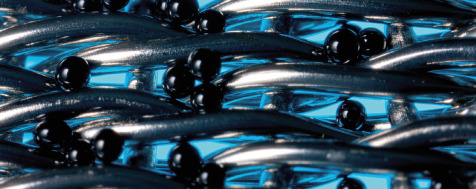
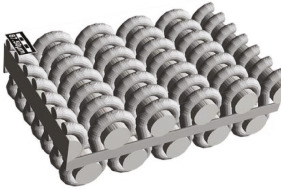
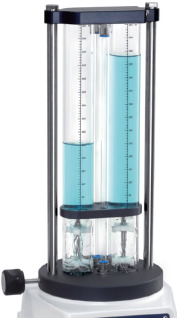
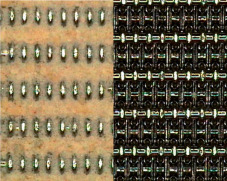
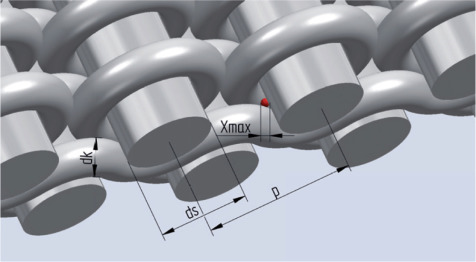
Several potential limitations stand in the way of efficiency, including the level of filtration required, the amount of contaminants within the fluid, the fluid's viscosity, the system's pressure and turbulence, and much more. While certain variables are fixed and others can't be predicted, system operators do have a choice in the type of filter they use. Making a simple change to that filter has the potential to make a major difference in achieving their filtration efficiency goals, as well as lowering the total cost of ownership of a filtration system. Whether filtering contaminants from water and wastewater streams, oil and gas processes, pharmaceutical solutions, electronics fluids, or any other fluid stream, the need for fine particulate filtration has created a challenge that sacrifices flow rates for filtration capabilities. System designers want maximum filtration to remove very fine contaminants in the 5-micron (μm) to 40-μm range. That means filters must have as small a pore size as possible. Yet, smaller pores limit flow and also require more energy to move fluids through the filter. As a result, fine filtration can potentially lack efficiency. The only way to increase the flow through a given filter would be to add more pores for more open surface area. That's physically impossible within the confines of a traditionally woven two-dimensional (2D) metal filter cloth. The cloth can only have a defined number of uniform pores within a given surface area. However, by moving to a three-dimensional (3D) woven metal filter cloth design, the number of pores and the open surface area of the filter can be doubled within the same dimensional confines and using the same pore size.
Double the flow rate
Doubling the open surface area of the filter doubles its flow rate, providing three primary benefits for end users: 1.They can process twice the amount of fluid per day without expanding operations 2. They can cut the time it takes to process a given volume in half to enable the production of more product batches per day 3. When specifying new equipment or retrofitting existing equipment, they can reduce the size of the equipment while maintaining or exceeding their original flow rate.
These benefits, which are enabled by a 3D woven metal filter cloth, represent considerable efficiency gains for a filtration system owner that can have an impact on the entire processing stream, both upstream and downstream. In addition, the 3D woven filter design offers the potential to reduce the cost of ownership reductions in several ways. These are related to minimized pressure loss, enhanced purging capabilities, extended filter life, reduced system downtime, wider material options, reduced energy consumption and streamlined specifications. This paper will review how the 3D filter design enables these efficiency gains and cost of ownership reductions.
Same pore size with double the flow
Filtration system operators and designers are under constant pressure to enhance the efficiency of their systems. The faster they can move fluid through the system, the better, as long as they're not sacrificing particle filtration in the process. This has traditionally been a tall order, given the existing physical limitations of a filter element which will be a defined size based on the equipment it's used in; it can only have a defined number of pores, and therefore open area, based on its dimensions; and designers can typically only alter the pore size of the filter to affect its flow rate. Yet, even when altering a filter's pore size, designers are bound by simple physics. You can't force any more fluid through a hole than what its physical size allows, and the smaller the hole, the lower the flow. Consider taking a flat, 2D piece of sheet metal and drilling one 5-μm hole through it. Fluid will flow through that pore at a low rate. Drilling one more 5-μm pore will double the flow rate. Drilling more 5-μm holes throughout the entire surface of the sheet metal will continue to increase the flow rate until there is no room for more holes. At this point, the sheet metal, which is now essentially a non-woven filter, has reached its total potential flow rate. The same would be true for a 2D woven metal filter cloth with uniform 5-μm holes throughout.
Going 3D
Because the flow rate through a filter is so closely tied to the total open area of the filter's pores, the best way to enhance the efficiency of the filter is to increase that open area by adding more pores and the only way to do that is by going 3D. By adding an additional layer of weaving, a 3D filter cloth like the MINIMESH RPD HIFLO-S metal woven filter cloth doubles the number of pores available for the given surface area of the filter element. Doubling the pores doubles the flow capacity, just as in the case of drilling the second hole in the 2D sheet metal noted above. The 3D weaving principle is different from simply stacking two 2D filter cloths on top of one another, which would just yield a double filter with no flow improvements. Instead, the MINIMESH RPD HIFLO-S uses a reverse plain Dutch weave that essentially offsets the top and bottom layers of pores, effectively creating twice as many pores within a single 3D filter element.
Minimizing system pressure loss
In addition to enhancing flow, doubling the number of pores for a given filter dimension also has important implications for managing pressure within the filtration system. Filtration system operators ideally want a balanced system that has equal pressure on either side of the filter. That also means having equal and consistent flow through the filter media. This ideal can be difficult to achieve with a conventionally woven, 2D filter cloth, as the cloth's open surface area limitations may not allow operators to achieve their desired balance. Simply put, the cloth may not have enough open surface area to let fluid pass through without pressure building upstream and dropping off downstream. Going back to the sheet metal example, a piece of metal with one 5-μm hole will have a large pressure differential on either side of the metal. Pressure will build on the upstream side as more fluid pushes against the metal, while pressure will be very low on the downstream side as minimal fluid flows through. Drilling more 5-μm pores through the metal will continue to relieve upstream pressure and reduce the pressure differential until there is no room for more holes. At this maximum open surface area, there will still be a pressure differential within the system, simply because there is a barrier – the metal of the filter element – between the upstream and downstream sides. More holes in this barrier will help, but that is not possible with a 2D filter cloth. Moving to the 3D weave structure of the MINIMESH RPD HIFLO-S doubles the number of holes within the filtration media's surface area, allowing double the fluid to pass through the filter. This helps to further decrease the pressure differential and helps operators better achieve a balanced, more efficient system.
Enhanced filter purging capabilities
While a properly designed filtration system may be balanced initially, downstream pressure is likely to decrease gradually over time as the filter cloth captures contaminants from the upstream fluid. Those contaminants, which are all larger than the filter's pore size, will progressively clog the filter, slowly reducing the open size of its pores and limiting the open surface area for fluid to move through. The phenomenon is not a deficiency of the filtration system, but rather an expected outcome of filtering out unwanted particulates. When a system operator notices that downstream flow has slowed and efficiency has dropped, it's time to check the filter for clogging. The unclogging process typically involves a system backflush that reverses fluid flow to push contaminants out of the filter. The process works best when contaminants are not physically bound to the filter cloth, as they typically are in a conventional 2D filter cloth. The 3-D MINIMESH RPD HIFLO-S filter cloth instead captures contaminants on the surface of the cloth, so they don't physically enter it and become stuck there. Therefore, contaminants wash away much easier from the 3D filter than they do from a conventional filter. The MINIMESH RPD HIFLO-S filter cloth can also capture more contaminants than a conventional filter without drastically reducing downstream pressure. This capability allows for longer backflushing intervals, which reduces system downtime and ownership costs.
Expanding filter material options
The total cost of ownership of a filtration system is also tied to the type of materials that can be used for the filter. Corrosion- and temperature-resistant materials help to maximize filter life due to their durability within process streams carrying hot and/or corrosive fluids. However, such materials have limitations in terms of the size of wires that can be produced. This restriction has traditionally limited the size of pores that can be created within a filter cloth, as well as the particle size the cloth can filter. Corrosion- and temperature-resistant materials, such as Alloy 310 S, Inconel 600, Superduplex, Duplex, Hastelloy C 22 and titanium, are brittle when they're extruded to very small-sized wires. The thin wires are often too brittle to enable weaving, which traditionally meant filter cloths made from exotic materials could only have pore sizes greater than 40 μm. However, the 3D weave structure of the MINIMESH RPD HIFLO-S metal filter cloth has changed this reality. It allows for the filter cloth to have pore sizes between 5 μm and 40 μm, while using thicker wires made from specialty materials. Therefore, it's possible to use corrosion- and temperature-resistant filter cloths with pore sizes smaller than 40 μm for the first time. This provides a wider range of possible applications for filtration system owners, who now have the capability to filter finer contaminants from corrosive and high-temperature process streams.
Streamlining filter specification
Another factor impacting the total cost of ownership of a filtration system is the filter specification process, which traditionally requires multiple rounds of trial and error. Historically, it has been difficult to match a filter element with a given system and have a clear idea of what the actual capabilities will be in terms of flow, filtration, turbulence and pressure drop. Equipment manufacturers must typically work with filter element suppliers to test various pore sizes and constructions within the actual equipment, taking time to run fluid through one filter, take measurements and then swap out the filter with a different pore size before going through the whole process again. To eliminate much of this guesswork, the MINIMESH RPD HIFLO-S filter cloth uses a more scientific specification process that precisely calculates numerous variables in advance and fine tunes them to the end use requirements. Using simulation software, designers can optimize a virtual woven filter cloth for a specific application and calculate the pore sizes, flow rates, turbulence and fluid dynamics before producing the actual cloth. These simulations essentially serve as a virtual trial-and-error process, while foregoing traditional physical trials. Ultimately, the filter cloth will need to be tested in the actual system to confirm it performs as expected. However, due to the scientific simulation process, the resulting filter cloth is highly likely to deliver the expected results with much less potential for running multiple trials. The simulation software plays a large role in streamlining filter design. However, such capabilities wouldn't be possible without being able to ensure the actual manufactured filter cloth will be produced as specified in the virtual simulation. The independent and internationally renowned institute Whitehouse Scientific has tested and confirmed that the MINIMESH RPD HIFLO-S has uniform, precision pores with extremely high cut-points and dimensional stability from manufacturing run to manufacturing run. Whitehouse Scientific confirmed these properties by performing glass bead tests and air flow-through measurements on various filter sizes. Further adding to filter specification efficiency, the MINIMESH RPD HIFLO-S filter cloth can be produced in multiple pore sizes from 5 μm to 40 μm within one production batch as desired. Production volumes can therefore be precisely matched to the specific requirements for end use testing. With conventionally-woven media, filter cloth manufacturers have to instead run one production batch for each pore size to be tested, creating a longer timeline for production, as well as end user trials.
Conclusions
While filtration system designers can make select adjustments to pumping pressures and flow paths to enhance the efficiency of their systems, the design of the filtration media has the most bearing on enhancing efficiency. By shifting from a conventionally-woven 2D filter cloth to the 3D MINIMESH RPD HIFLO-S filter cloth, designers have the ability to double their system flow rates while still filtering the same size of particles. This enables owners to avoid sacrificing filtration capabilities at the expense of increasing flow-through rates. In addition, the design of the 3D filter cloth can help minimize pressure loss, extend the filter's life and reduce system downtime. Under pressure to increase the energy efficiency of a filtration system, designers now have a solution that not only doubles the capacity of the system, but also helps to reduce its total cost of ownership.




